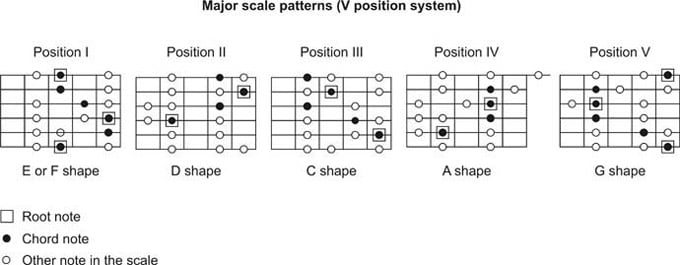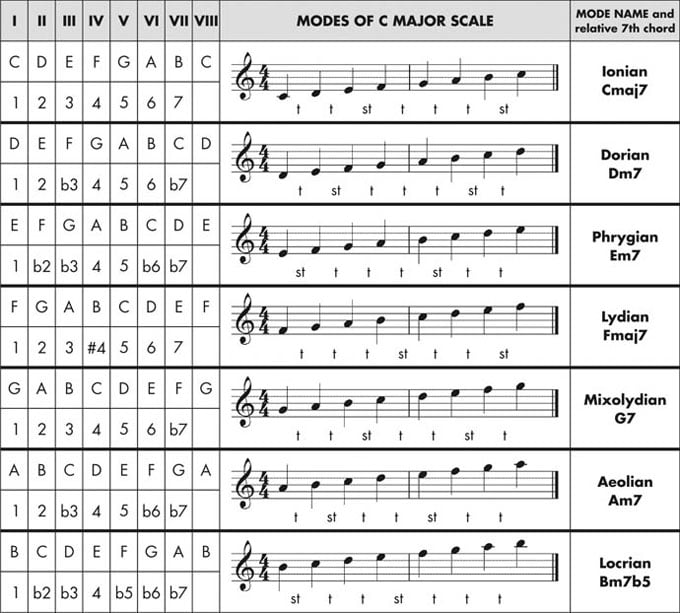now playing:
- main
- 1
- 2
- 3
- 4
- 5
- 6
- 7
- For members8
- For members9
- For members10
- For members11
- For members12
- For members13
- For members14
- For members15
More
- Licks In All ModesLEVEL 5All 7 Modes of the C Major scales presented with cool licks
- 7 Modes in 7 KeysLEVEL 5All 7 Modes (Ionian, Dorian, Phrygian, Lydian, Mixolydian, Aeolian & Locrian) in 7 Keys demonstrated in 14 cool licks
- All Melodic Minor ModesLEVEL 5All 7 Modes of the C Melodic Minor scale presented with some cool licks
- Melodic Minor 7 ModesLEVEL 5All 7 Modes of the melodic minor scale in 7 different Keys demonstrated in 7 cool licks
- 7 Harmonic Minor ModesLEVEL 5All 7 Modes of the Harmonic minor scale in 7 different Keys demonstrated in 7 cool licks
- Acoustic Solo C MajorLEVEL 2Crete super soft solos by playing a simple scale. The magic will come from the beautiful acoustic guitar sound.
- C Major Rock Solo (Satchy)LEVEL 6In this lesson we have a rock solo. Here you'll find different guitarist influences as Joe Satriani, Paul Gilbert & Steve Vai.
- Modal Metal SoloLEVEL 7I made this exercise inspired by two of my favorite players, Marty Friedman and Jason Becker, and their Cacophony saga.
- Fusion LicksLEVEL 7Illustration of effective fusion changes and the corresponding scalar choices with typical fusion phrasing.
Feedback
Adaham15th January 2012
This is a very clever way to play the modes of major scale. I will learn this one. TQVM Emir. I love this lesson.
 Emir Hot11th December 2008
Emir Hot11th December 2008Cheers kjutte, this one is really useful if you want to know about major scale modes
 kjutte11th December 2008
kjutte11th December 2008This kind of lessons gets way too little attention, great that we have more!
 Kapto9th October 2008
Kapto9th October 2008Bookmarked !
Thanks a lot Emir Emir Hot8th October 2008
Emir Hot8th October 2008Thank you Kristofer
 Kristofer Dahl8th October 2008
Kristofer Dahl8th October 2008Very nice lines Emir!
 Muris Varajic6th October 2008
Muris Varajic6th October 2008
Oups
Igor,right
 Sergio Dorado5th October 2008
Sergio Dorado5th October 2008Great lesson as always!
 Emir Hot5th October 2008Ivan gave you Dean after all,
Emir Hot5th October 2008Ivan gave you Dean after all,
great playing bro!!
You mean Igor
yes I took it for some of my upcoming lessons. Great guitar. Nazgul5th October 2008
Nazgul5th October 2008Great! Well done Emir!

 Muris Varajic5th October 2008
Muris Varajic5th October 2008Ivan gave you Dean after all,
great playing bro!!
 Ivan Milenkovic5th October 2008
Ivan Milenkovic5th October 2008Very nice and smooth, cool bass line.
 Nemanja Filipovic5th October 2008
Nemanja Filipovic5th October 2008Great lesson Emir.

 Dejan Farkas4th October 2008
Dejan Farkas4th October 2008Sounds great, well done

fatb0t4th October 2008
I envy youuuuuuuuuuuuuuuuuuuuuuuuuuuuuuuuuuu
 Hisham Al-Sanea4th October 2008
Hisham Al-Sanea4th October 2008very good lesson Emir. useful
 JVM4th October 2008
JVM4th October 2008Nice. This is what I'm working on, thanks Emir.
 Emir Hot4th October 2008
Emir Hot4th October 2008thanks guys
 Gabriel Leopardi4th October 2008
Gabriel Leopardi4th October 2008Amazing way to study the modes!
 kaznie_NL4th October 2008
kaznie_NL4th October 2008Great info on modes Emir! I thought it was much complexer, but this explained it very clearly!! Thnkx

 Marcus Siepen4th October 2008
Marcus Siepen4th October 2008cool lesson
 Jerry Arcidiacono4th October 2008
Jerry Arcidiacono4th October 2008Useful lesson & cool solo

 Bogdan Radovic4th October 2008
Bogdan Radovic4th October 2008Cool lesson Emir !!

 Capt.Z4th October 2008
Capt.Z4th October 2008Awesome lesson!!

 Emir Hot4th October 2008
Emir Hot4th October 2008Thank you guys. Yes, it's a Dean. I tried it for a change.
 Vasilije Vukmirovic4th October 2008
Vasilije Vukmirovic4th October 2008Very melodic!
 Kuba Szafran4th October 2008
Kuba Szafran4th October 2008Great and useful stuff!
 Toni Suominen4th October 2008
Toni Suominen4th October 2008Very useful lesson Emir!

 Pedja Simovic4th October 2008
Pedja Simovic4th October 2008Emir cool lesson , love the CAGED system

 mattacuk4th October 2008
mattacuk4th October 2008Excellent Emir

 Jad Diab4th October 2008
Jad Diab4th October 2008Great lesson, really interesting and well explained

 Bondy4th October 2008
Bondy4th October 2008Cool Emir not seen that guitar before either Emir is it new?
 RIP Dime4th October 2008
RIP Dime4th October 2008Great solo, is that a Caddy?
 Ian Bushell4th October 2008
Ian Bushell4th October 2008Really informative lesson, and nice lines Emir:)
Is that a dean?
Metal geet for jazzy licks...that's rock n roll! haha
Practicing Peers
- Total views: 0
- Member views: 0
- Guest views: 0
- Lesson
- My notes
Hello everybody! I am sure that many of you know modes of a major scale especially of C major scale. I am not sure whether there was a lesson like this before but I will show you how I connect modes all over the guitar neck using V position system.
For those who might not be familiar with major scale modes here is an introduction. We know that major scale has 7 notes and its formula is made of intervals in order: 1, 2, 3, 4, 5, 6, 7. Here is the description of these numbers which we call INTERVALS (distance between 2 notes).
1 – unison
b2 – minor second
2 – major second
b3 – minor third
3 – major third
4 – perfect fourth
#4/b5 – augmented fourth / diminished fifth
5 – perfect fifth
b6 – minor sixth
6 – major sixth
b7 – minor seventh
7 – major seventh
8 – octave (this is not included in a scale formula as this is the same note as 1)
If we take the second note of C major scale (note D) and set that as our new root but continue to play C major scale notes until the next D note - we played a mode of C major scale (D Dorian). From here we can conclude that a major scale has 7 modes (including the major scale itself). Their names are: Ionian (major scale), Dorian, Phrygian, Lydian, Mixolydian, Aeolian and Locrian. Each of these modes has its own formula and a relative chord when the mode is harmonized. Those modes and their formulas are explained on the picture below.
Harmonization of C major scale into 4 note chord.
The term harmonization in musical context means superimposing intervals of the scale on top of each other - in this case 3rd on top of 3rd and so on. To harmonize C major scale into 4 note chord we would take the root, 3rd, 5th and 7th (5th is 3rd away from 3rd and 7th is 3rd away from 5th). If we take that formula and apply on C major scale we would get the following notes: C, E, G, B and this will give us "maj7" chord. If we apply this chord formula on the second mode of C major scale (D dorian) whose scale formula is: 1, 2, b3, 4, 5, 6, b7 – we would get a chord formula 1, b3, 5, b7 or D, F, A, C which gives us a minor7 chord. If we play these 4 notes one after another (not at the same time), we played a minor 7 arpeggio. All 7 chords from harmonized C major scale would be: Cmaj7, Dm7, Em7, Fmaj7, Am7, G7, Bm7b5 (see picture below).
About the lesson:
In this lesson I played a solo over all 7 chords mentioned above using relative mode for each chord. Each chord is one bar long and I included on screen writing so you don’t get confused. My way of modal improvising works the best if I use V position scale system. See the diagram bellow showing 5 position system for major scale. Once you learn this, you actually know all modes of a major scale in all 5 positions. If you are playing C major scale in position I, you are actually playing D Dorian mode in position V, and so on. Every mode has its own V positions but the pattern looks the same as for the major scale. Just be careful where you set your root and the patterns are all the same. In this lesson I played many modal licks to show you how I connect these V positions on the guitar neck in order to make a melody that makes sense.
I hope you will find this topic useful and have fun with modal improvising.
Emir

Jump to start: Home or `s` , you can also click/tap the lesson part again (the numbers above player)
Go to next part: PageUP or End.
Volume: ArrowUp / ArrowDown keys
Go to any part: Number keys (combinations also possible)
Pause or play: `k` or space key
Fullscreen: `f`, esc to close
Increase / decrease speed : `+` or `-`







